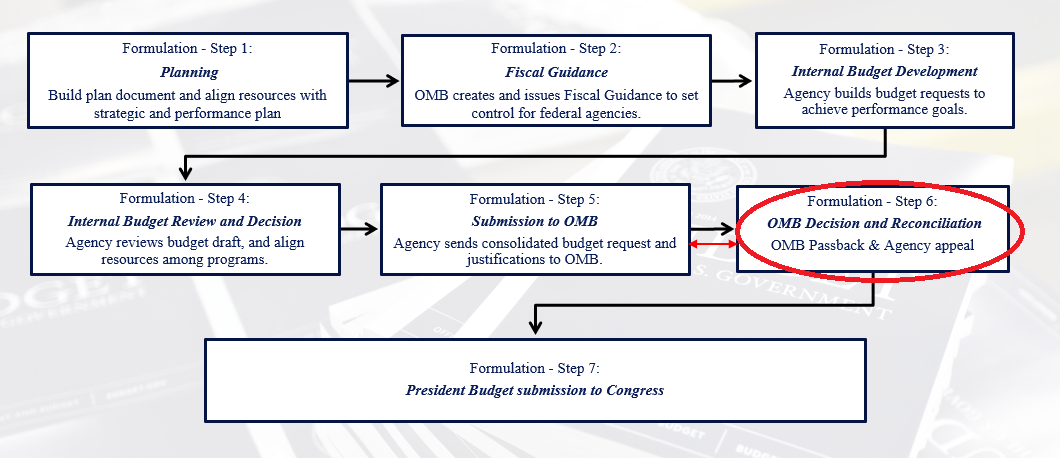Formulation - Step 6: OMB Decision and Reconciliation

In early fall, agencies submit their budget requests to OMB, where analysts review them and identify issues that OMB officials need to discuss with the agencies. OMB and the agencies resolve many issues themselves. It is expected that agencies will seek more funds for programs in their jurisdiction and that OMB will seek to constrain budgetary growth. This process begins with OMB review of agencies OMB submission, follows with Passback (traditionally the Monday following Thanksgiving), and ends with OMB's settlement direction.
Passback (“Passed-back”) is the OMB’s formal response to the Federal agencies on their annual budget requests. The OMB may increase, decrease, or maintain budget totals. The Passback process and the content of Passback decisions has differed under each Administration and each OMB Director. Passback may also include program policy changes or personnel ceilings. The settlement document provides post-appeal OMB guidance to which agencies will comply. Passback and settlement may also detail requirements for new reports or deliverables that the federal agencies will provide to OMB. After receiving Passback, agencies usually have a 72-hour turnaround window in which to analyze the guidance and submit any appeals and justification materials. It is not uncommon for OMB to conduct additional information gathering and analyses before issuing its settlement position. OMB's delivery of settlement can also be delayed by events occurring in Congress or the Administration.
The agency needs to analyze the impact of the Passback, conduct technical review with consideration of political impact, develop a strategy to guide through the process, and carefully make decision whether to appeal or not. Agencies may choose to submit an appeal on one or more elements (often termed a reclama) to the OMB Director. To support the appeal, agencies should provide justification materials and engages in discussion with OMB until OMB finalizes its budget guidance and programmatic decisions in the settlement. This decision-making process is usually completed by late December around Christmas. Depending on the procedures established by the OMB Director, it may require the involvement of White House policy officials and the President.
The final stage before deliver to Congress is to adjust and reconcile detailed budget data and the preparation of the budget documents. The decision-makers must consider the effects of economic and technical assumptions on the budget estimates. Interest rates, economic growth, the rate of inflation, the unemployment rate, and the number of people eligible for various benefit programs, among other factors, affect Government spending and receipts. Small changes in these assumptions can alter budget estimates by billions of dollars. Thus, the budget formulation process involves the simultaneous consideration of the resource needs of individual programs, the allocation of resources among the agencies and functions of the Federal Government, and the total outlays and receipts that are appropriate in light of current and prospective economic conditions. Final numbers are locked in OMB budget systems, Congressional roll-out materials and President’s Budget volume and Appendix are finalized in January.
Previous: Formulation - Step 5: Submission to OMB Next: Formulation - Step 7: President Budget submission to Congress